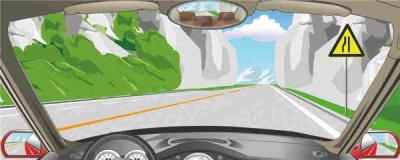1、Which lamp should be used when motor vehicles pass hrough an intersection at night where there is no traffic light signal?
A、High-beam
B、Low-beam
C、Hazard lamps
D、High-beam and low-beam should be used alternatively
Answer:D
2、The sign on the right indicates left turn only at the intersection ahead.

A、Right
B、Wrong
Answer:A
3、It is illegal to change lanes without turning on indicators.
A、Right
B、Wrong
Answer:A
4、On which of the following roads may the wheels be most easily locked when braking?
A、Concrete road
B、Dirt road
C、Road covered by ice and snow
D、Sand road
Answer:C
5、When parking for a long time on a downward slope due to breakdown on the road, drivers should use this method to stop up wheels.

A、Right
B、Wrong
Answer:A
6、As shown in the flash, the actions of the driver are correct.

A、Right
B、Wrong
Answer:B
7、Mr. Wu drove a large bus with 33 passengers (capacity 22 people). At the spot of 7 kilometers mark by 300 meters on the No 163 County Road, the bus lost control and fell into a ravine. As a result of the accident, 10 people were killed and 21 injured. In accordance with the alcohol test after the accident the blood alcohol content of Mr Wu was 26 milligram per milliliter. What's the main illegal act committed by Mr Wu?
A、Speeding
B、Carrying more passengers than permitted
C、Fatigued driving
D、Driving after drinking
Answer:BD
8、During normal driving, the driver should do his/her best to run close to or on the central line so as not to allow oncoming vehicles any opportunity to occupy his own route.
A、Right
B、Wrong
Answer:B
9、The area in the yellow rectangle markings on the right side of the road indicates that temporary stopping is permitted here.

A、Right
B、Wrong
Answer:B
10、What should be done first after getting into the vehicle?
A、Observe the surrounding traffic situation
B、No need to observe the traffic situation around
C、Open the door and get in directly
D、Take note of the weather
Answer:A
11、When an erosive material catches fire, it should not be put out with water cannon.
A、Right
B、Wrong
Answer:A
12、When driving a motor vehicle not equipped with the anti-lock braking system(ABS), what should the driver do if he/she brakes on a road covered by ice and snow?
A、Gently or intermittently depress the brake pedal
B、Depress the brake pedal as on other roads
C、Violently depress the brake pedal
D、Suddenly depress the pedal with force
Answer:A
13、The sign on the right warns of an embankment road 200 meters ahead.

A、Right
B、Wrong
Answer:A
14、After a motor vehicle falls into water, the driver won't be able to open the side doors or windows to escape until water nearly fills up the compartment.
A、Right
B、Wrong
Answer:A
15、When a wounded person is beneath the wheel or cargo, we should help him/her out immediately by pulling the limbs of the wounded.
A、Right
B、Wrong
Answer:B
16、Before driving, it is necessary to check whether the cooling liquid, engine oil and fuel oil, are leaking.
A、Right
B、Wrong
Answer:A
17、When the vehicle engine catches fire, what should the driver do first?
A、Turn off the engine as soon as possible
B、Extinguish the fire with water
C、Open the hood to extinguish the fire
D、Extinguish the fire from the leeward direction
Answer:A
18、Which of the following is a bad driving habit?
A、Using lights in accordance with relevant rules
B、Carrying both vehicle and driving license
C、Discarding rubbish from the side window
D、Follow the guidance of the traffic signals
Answer:C
19、The sign on the right warns of a widened left-hand road ahead.

A、Right
B、Wrong
Answer:B
20、Mr. Qian drove a large sleeper coach with 45 passengers (capacity 40 people) at a speed of more than 40 kilometers per hour. On a long slope with sharp curves in Basu County, the coach fell into a 100-meter-deep valley, killing 17 people and injuring 20. What's the main illegal act committed by MrQian?
A、Making a cellphone call while driving
B、Speeding
C、Carrying more people than permitted
D、Fatigued driving
Answer:BC